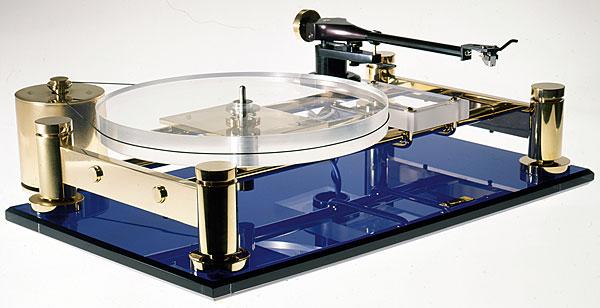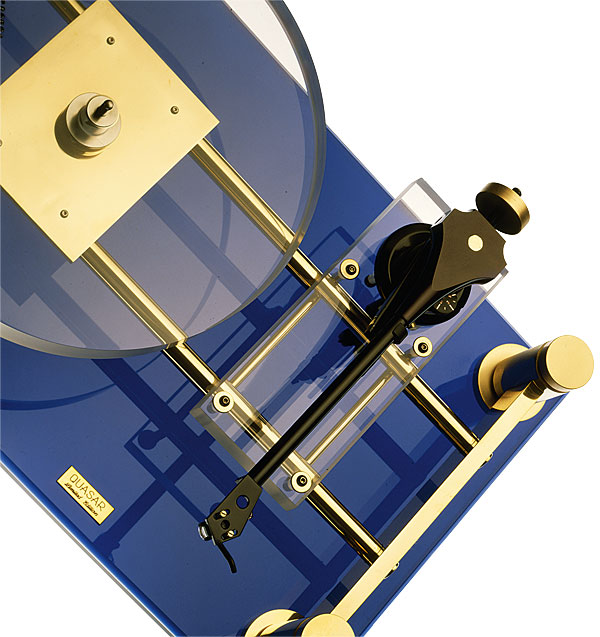Star Potential

 There's a glowing new object in the hi-fi galaxy – the Quasar turntable. Ken Kessler makes space for a deck with a sound as sweet as sugar
There's a glowing new object in the hi-fi galaxy – the Quasar turntable. Ken Kessler makes space for a deck with a sound as sweet as sugar
Gorgeous. That's the word I kept hearing, every time someone noticed the Quasar LE turntable while it was in for review. And one of the first to utter it was the owner of a Michell Orbe, itself no canine. What these individuals cooed over is one of the prettiest LP spinners to come along since the first Oracle. And that's one hell of an antecedent.
It's not that farfetched, either, as the Quasar is virtually 'plinthless', just like the Oracle, as well as most Michell decks and a few other belt-driven alternatives to the more conventional Linns, Roksans and the like. The complete works are there for all to see, with four spring-filled pillars supporting a frame that carries both the bearing/platter assembly and the armboard.

The motor itself, which is situated completely 'outboard', is detached as much as is possible without defying reality; it's physically linked to the Quasar only by the belt. This isolationism, though, presents a minor problem, as the Quasar doesn't arrive with a template to help you locate the motor precisely. This is an issue I'll get to later, but first: Why The Quasar Stops People Dead In Their Tracks.
Look Right
Sound By Design sent the base model to us for the review, the £1780 Quasar LE, fitted with a Helius tonearm and needing no setting up on my part. But I did watch as Predrag Savic unpacked it and noted that the device's simplicity and elegance combined not just to make set-up straightforward and intuitive, but to support the adage that if something looks right, it is right. It's doubtful whether or not there's any truth to that belief, since the worlds of hi-fi, motoring, etc, are full of aesthetic triumphs which are functional failures, like Lancia Gammas and Strathearn turntables.
But the Quasar LE looks as right as it gets, with a cylinder at each corner, connected by transverse bars. To these are fitted a pair of rods which make this turntable so truly user-friendly: the rods support the armboard and bearing, both of which can be moved with ease to allow the Quasar to support two tonearms, either 12in or 9in, whichever the owner cares to match to the basic structure.
It's deceptively large, especially if the standalone motor assembly is relegated to the importance of an afterthought when you do your planning. In basic, single-arm form, the Quasar has a 545x325mm (wd) footprint, and you must allow another 300mm or so for the motor unit. If you opt for two arms, the width increases to 370mm because both tonearms are mounted so as to extend past the baseboard and so look like they're floating.
Proof Of Concept
But it's so damned svelte that it never seems massive, even in double-limb form, the chrome, brass and acrylic blending together with surprising harmony. Even the deluxe versions with gold-plated parts and marble-look base-plates remain tasteful and understated, despite suffering a verbal description which could apply to the bathroom in an upscale bordello. Nothing about the Quasar's design philosophy is bizarre, outré, odd or jarring.

The external motor unit is an obvious example. By relegating it off-campus, there is simply no way that motor noise or vibration can interfere with the deck itself. If isolating the motor from the turntable was a part of the original impetus for creating belt-drive decks in place of the once dominant idler-drive deck, then Quasar has taken the concept as far as it can go.
Initial Stupidity
We discussed the notion of supplying the Quasar with a spacer or template to help the customer locate the motor relative to the deck (the owner's manual suggests a not-sufficiently-precise-by-my-reckoning '225-230mm' from spindle to pulley), and then to centre it. But it then occurred to me that Savic was being polite by ignoring my initial stupidity. Because any sort of frame, template or spacer used to position the motor relative to the deck would violate the near-total isolation offered by the present hands-off set-up. Which implies that, should the company ever produce a set-up jig, it would be used only during the installation, then removed.
Quasar's aforementioned mix of materials isn't purely aesthetic. The baseboard is an acrylic laminate and the main chassis is brass, while armboards and platters in acrylic (beloved for its resemblance to the behaviour of LP vinyl) have been politically approved for years – all the materials have been chosen to complement each other according to their damping and resonance properties. Nothing new here: it's just common sense and a readily-admitted respect for revered designs from the past. So, too, then, the use of a record clamp, a slightly undersized spindle to 'decouple' it from the LP, a suspension so easy to adjust that it seems to be nearly self-levelling and a chassis with enough mass to obviate the need for near-neurotic attention to tonearm cable trimming. The assembly weighs 18kg, a substantial amount for something so deliciously skeletal.
Taken For A Ride
Other details include the housing of the motor in a 3.3kg solid brass cylinder, a stepped pulley to allow 33 and 45rpm playback, a non-inverted bearing, an armboard that can be changed simply by removing four screws and the absence of a dust cover ('Why hide all this beauty?' is probably the argument against providing a dust barrier...).


















































